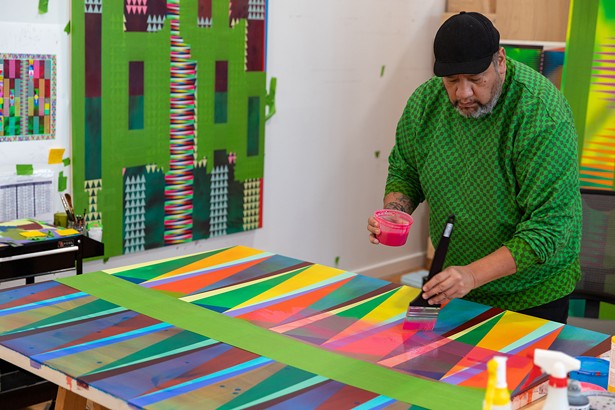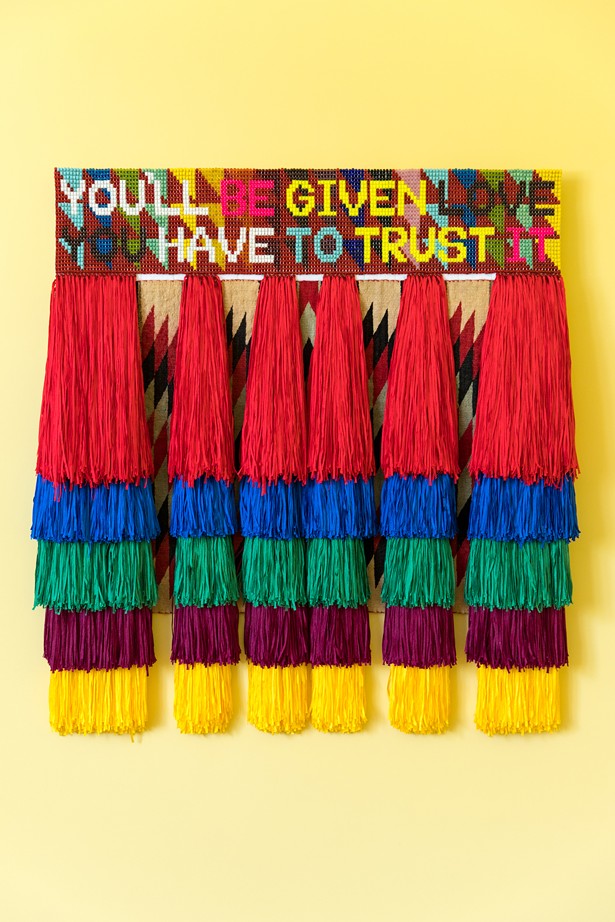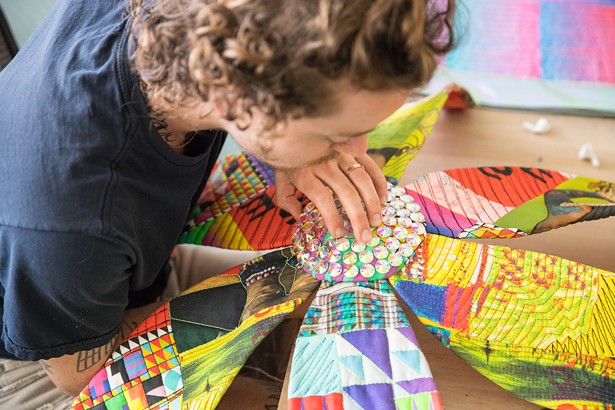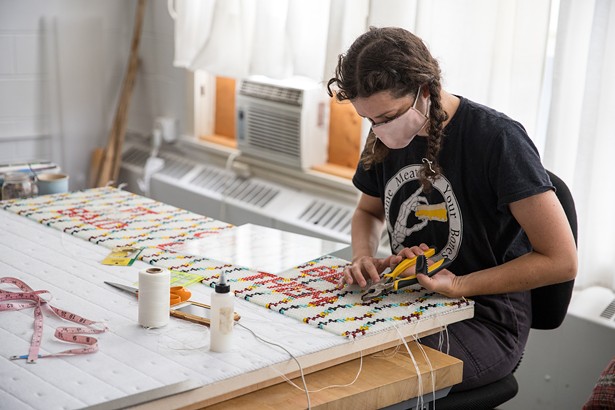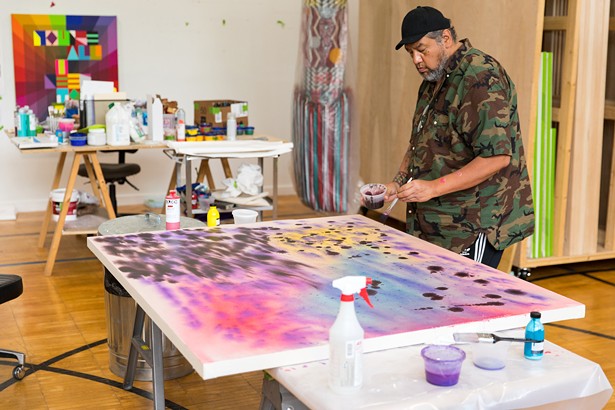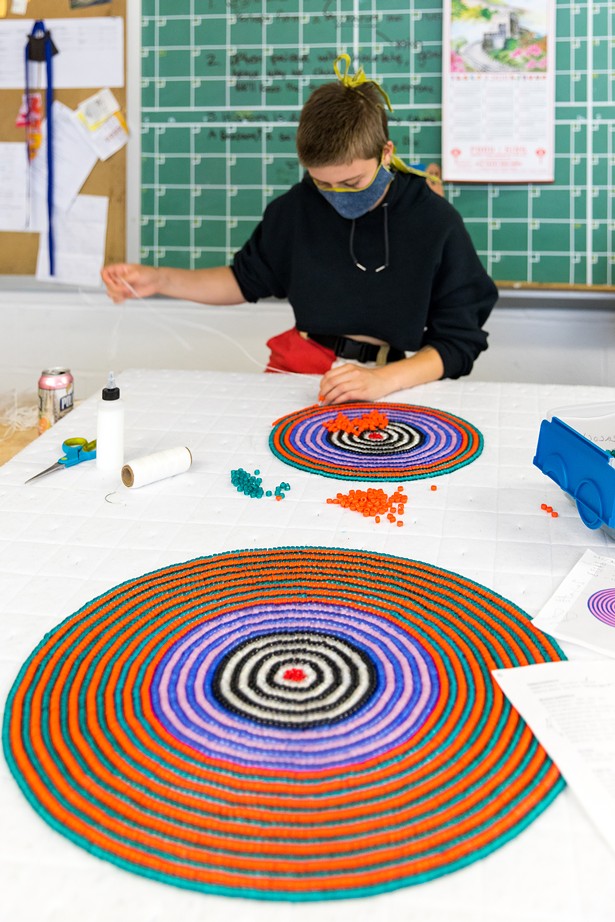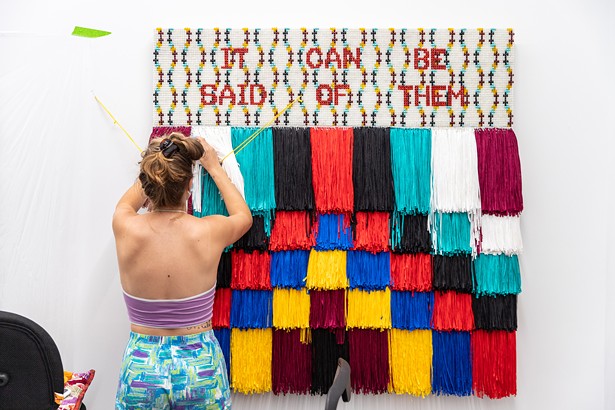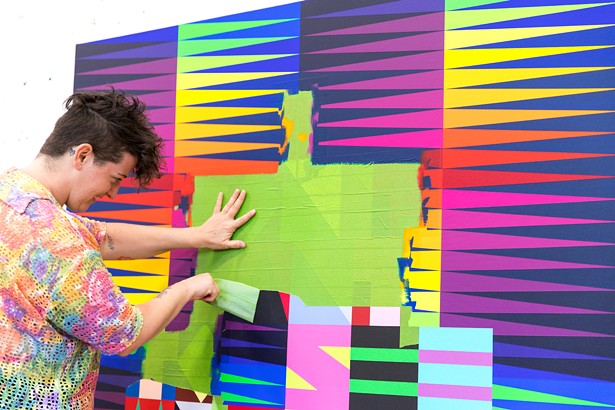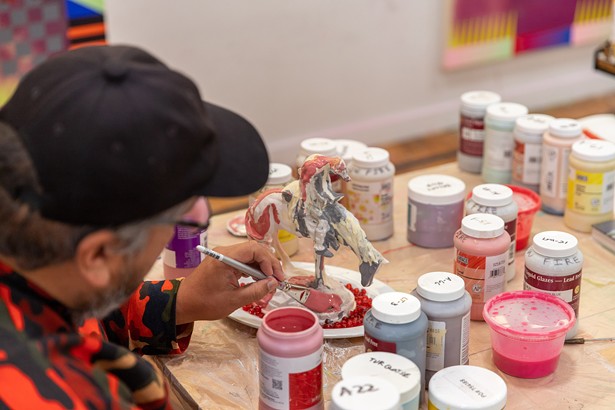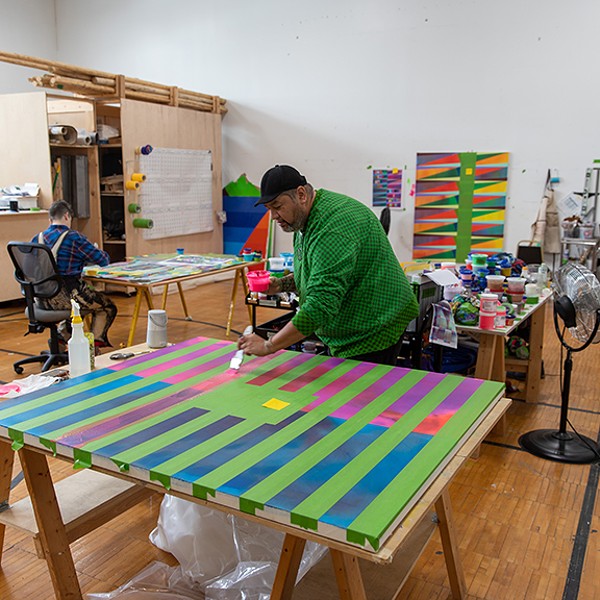Jeffrey Gibson (b. 1972) is a multimedia artist based in Hudson. Gibson’s dynamic art practice explores a diverse cross-section of influences, including Native American indigenous craft traditions, cultural narratives, symbols of power, history, personal identity, and contemporary social issues relevant to BIPOC and queer communities.
His singular creative style embraces a range of mediums for expression, such as textiles, embroidery, weaving, hand-sewn fringe, beadwork, and other materials that are the basis for his vibrant assemblage-based paintings, sculptures, garments, and large-scale installations. Gibson’s work often recontextualizes and thus reconsiders traditional Native American craft within a contemporary cultural framework, resulting in a body of work that is both conscious and celebratory. He regularly exhibits his art at major institutions worldwide and his work is represented in numerous museum and private collections. I spoke with Gibson over Zoom earlier this year. This is an edited version of that conversation.
—Taliesin Thomas

Taliesin Thomas: Please share any comments about your Native American roots and the Hudson Valley as your home and place of artistic creation. What brought you to the Hudson Valley?
Jeffrey Gibson: Well, you know, my ancestry is not from this area originally. My families are located in Mississippi and Oklahoma. My mother is Cherokee and my father is Mississippi Band of Choctaw Indians and so I have grown up being aware of both of those, but I am a member of the Mississippi Band of Choctaw Indians.
I originally came to Columbia County in 2007 for a residency at Art Omi. We moved up here in the summer [of 2012]. And then the studio started growing and then I bought this building that I am in now, which is a turn-of-the-century schoolhouse in Claverack.
At that time of my life I was 40, so the goal was to put down some roots and do a little life editing and to secure the things that we knew we wanted to do: my art career, [my husband] Runey’s art practice, and a family.
TT: Your celebration of indigenous Native American culture through your art articulates a vibrant spectrum. How is that spectrum changing?
JG: I think my shift of considering a Native American indigenous contemporary art and culture audience is something that I know is always in the forefront of my brain now and I can feel where it’s been developing. I think when you are Native, you are kind of held accountable by your family, by your community, by other people, whether they are part of your tribal nation or not.
No one is speaking to indigenous audiences from that contemporary art world, and so that to me became something that I was interested in. Maybe even not as a curiosity, just sort of ‘What does that mean to speak to other indigenous artists?’ So, I have to assume that to some degree we are people who, regardless of what our relationship is to our community—meaning how traditional or not traditional—we have all chosen to make art and put it out into the global world.
That’s increased the spectrum a lot [and] rather than extending my own self, I find the people who I am inspired by and I ask then to come together and for me to be able to do the best of what I do, and set it up as a platform for them to do the best that they can do.
TT: You have said that you almost gave up doing your art. Please share any thoughts about this soul-searching as an artist.
JG: That really goes back, really from the period we moved to New York. Runey and I moved together from London in 1999.
I was exhibiting, and I think for me commercial success has really been important because it was sort of a barrier to break. I was pretty determined to also be a part of that part of the art world and not just remain in nonprofit spaces that were speaking to larger issues. I have been trying to juggle a lot of that all of these years.
I guess it was somewhere around 2008, that’s sort of the point for me. A couple of times, I thought about just walking away from it. I think I also expected, growing up, that the art world was a meritocracy. I thought that it was totally inclusive, I thought it was completely queer friendly. So, to get there and run into kind of heteronormative, kind of machismo, and class issues, and race issues, was really disheartening. I couldn’t find the reason big enough to want to put up with it.
And, at the same time, I am having these conversations with academics, scholars focused on indigenous making, historical indigenous making. That conversation, to me, is so important and so large—so to come into the art world, where no one was aware of it, just feels like you are walking off a cliff.
It was deciding: Am I worried about it being stereotypical, me identifying as Native American. “Am I pigeonholing myself?” is the question that came up numerous times.
I had to turn all those voices off long enough to make the work to see, what does this feel like to do this, to learn bead work? I had learned some beadwork in my teens and 20s, but actually applying it in any kind of substantial way did not happen until around 2008 to 2011.
That was the first time I felt the city that I always wanted to be an artist in, New York City, finally noticed me and paid attention. That was the big shift.
TT: Your art is powerful, empowered, and empowering all at once, it does all of that. How do you define power in art?
JG: Oh, that’s a big question. Power in art: I think there are lots of different kinds of power, right?
And so, I think the garments that I make, the power that comes from them…I think when somebody puts them on, which is a huge part of them, somebody has to put them on, whether it’s me or somebody else…those individuals that I put in the garments, their personal narratives become intertwined by my personal narrative and it leaves an archive that is powerful, that is present tense, that will describe me, of course, but also what was happening in the spaces that I moved through.
I think there are other kinds of power, of course, but I think that for me there is a genuine belief in the animation of materials and of putting together a space.
TT: Your exhibitions are a collaboration of ritual objects, costumes, paintings, installation, dance, music, and performances. How does this come together for you?
JG: I remember the days when I was doing everything, right?
In order to make enough to do a show, to fill a museum space, that’s where the team happened. I think so many of the artisans I have spoken with and people who are really invested in craft, it is therapeutic. That kind of repetitiveness, I think it does heal you. It occupies a certain place and also has the ability to heal you. And I feel like all of the beading that I have done, all the sewing that I have done, it did.
This is not something we do in our lives. We are the most minuscule parts of a bazillion transactions that happen every day, and I think it leaves us feeling fragmented. It echoes every symptom of schizophrenia. Craft and the kind of long process of making something is for me very healing, and now that process includes other people, it includes communication, it includes experimentation. My moment of realization, at this point, really happens when I see the work installed and I see how people engage with it, that’s when I get the rush.
TT: The idea of Futurism seems to be an expanding idea in the art world. Do you have any ideas about Futurism with respect to your work?
JG: I started talking about Futurism a long time ago. I think I started talking about it, about the need to be present. We can’t begin to think about a future unless we can feel really grounded in the present tense, so that is where a lot of my thinking about materials and the kind of extraordinary-ness that you can do in quite simple ways, you know, in color—these sorts of things, things that can bring you back to being in one place.
Then, to look at a future is actually quite scary because if you have clarity in the present, you see these seemingly insurmountable kinds of challenges ahead of us, mainly ecological. People who know me, I talk a lot about fear and anger. Of course, people are afraid, and of course they are angry. But we can’t solve these problems from fear and anger.
There is a power in positivity, there is a power in love, there is a power in not being afraid, there is a power in releasing anger. You are actually more powerful when you can release these things rather than holding on to them.
TT: What advice do you have for this younger generation of artists rising up and grappling with all these same issues?
JG: I worked with a professor at the School of the Art Institute of Chicago named Maureen Sherlock, [and] the takeaway that I got from her that I still hold on to is: Your opportunity to have freedom exists between well mapped marked spaces. It’s before things form, and the boundaries are set, and the rules are set, and the perceptions are set, that things start getting a little more tight and narrow and stifling. If you can find a space in between, you can define it, you can be whatever you want to be.







